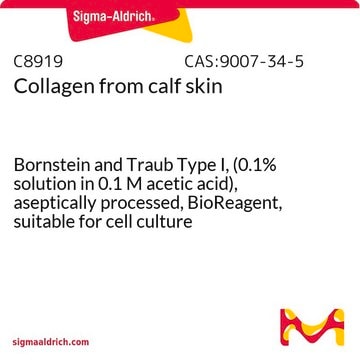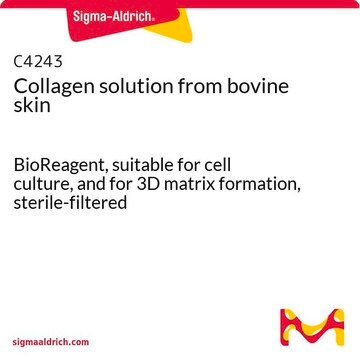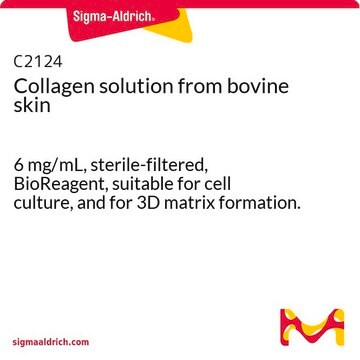C9791
Bovine Collagen Type I
from bovine skin, powder, suitable for cell culture
Synonym(s):
Type I collagen
About This Item
Recommended Products
product name
Collagen from calf skin, Bornstein and Traub Type I, solid, BioReagent, suitable for cell culture
biological source
bovine (calf) skin
product line
BioReagent
form
solid
packaging
poly bottle of 10 mg
poly bottle of 100 mg
poly bottle of 250 mg
poly bottle of 50 mg
technique(s)
cell culture | mammalian: suitable
surface coverage
6‑10 μg/cm2
solubility
0.1 M acetic acid: 1 mg/mL (Allow to stir at room temperature 1-3 hours until dissolved.)
UniProt accession no.
Binding Specificity
Peptide Source: Fibronectin
Peptide Source: Laminin
shipped in
ambient
storage temp.
2-8°C
Gene Information
bovine ... COL1A1(282187)
Looking for similar products? Visit Product Comparison Guide
General description
Application
- as a component of collagen gel matrix for culturing preantral follicles
- as a component of Roswell Park Memorial Institute, for culturing gilthead seabream kidney leukocytes and macrophages and acidophilic granulocytes
- to coat transwells prior to seeding of epithelial cell culture
Biochem/physiol Actions
Components
Preparation Note
Other Notes
Storage Class Code
11 - Combustible Solids
WGK
WGK 1
Flash Point(F)
Not applicable
Flash Point(C)
Not applicable
Personal Protective Equipment
Certificates of Analysis (COA)
Search for Certificates of Analysis (COA) by entering the products Lot/Batch Number. Lot and Batch Numbers can be found on a product’s label following the words ‘Lot’ or ‘Batch’.
Already Own This Product?
Find documentation for the products that you have recently purchased in the Document Library.
Customers Also Viewed
Articles
Extracellular matrix proteins such as laminin, collagen, and fibronectin can be used as cell attachment substrates in cell culture.
Cancer stem cell media, spheroid plates and cancer stem cell markers to culture and characterize CSC populations.
Our team of scientists has experience in all areas of research including Life Science, Material Science, Chemical Synthesis, Chromatography, Analytical and many others.
Contact Technical Service









